| This chapter implements STANAG 2990. |
Appendix D
Air Volcano
The air Volcano system provides a three-dimensional capability that allows units to emplace minefields in deep, close, and rear operations. It provides US forces with the capability to employ minefields rapidly under varied conditions. The air Volcano can be used to emplace tactical minefields; reinforce existing obstacles; close lanes, gaps, and defiles; protect flanks; and deny the enemy use of potential air-defense sites. Volcano minefields are ideal for flank protection of advancing forces and for operating in concert with air and ground cavalry units on flank-guard or screen missions.
COMPONENTS
The air Volcano system (Figure D-1) consists of an M87-series mine canister, an M139 dispenser, and vehicle-specific mounting hardware (UH-60 Blackhawks require a jettison kit).
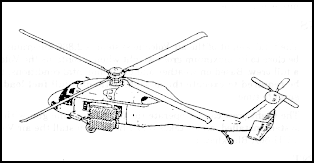
Figure D-1. Air Volcano system
M87-SERIES MINE CANISTER
The M87-series mine canister is the same canister used for the ground Volcano system:
- M87. Prepackaged with five AT mines, one AP mine, and a propulsion device inside a tube housing.
- M87A1. Prepackaged with six AT mines and a propulsion device inside a tube housing.
The mixture of mines is fixed and cannot be altered in the field. The mines in each canister are electrically connected with a web that functions as a lateral dispersion device as the mines exit the canister. Spring fingers mounted on each mine prevent the mine from coming to rest on its edge. AT mines have a delay-arm time of 2 minutes 30 seconds; AP mines have a delay-arm time of 4 minutes. All canisters are capable of dispensing mines with 4-hour, 48-hour, or 15-day SD times. SD times are selected prior to dispensing and do not require a change or modification in the base M87-series mine canister.
M139 DISPENSER
The M139 dispenser consists of an electronic DCU and four launcher racks; each rack holds 40 M87-series mine canisters. The racks provide the structural strength and the mechanical support required for launch and provide the electrical interface between the mine canisters and the DCU. Mounting hardware for the UH-60A Blackhawk includes a jettison subassembly to propel the Volcano racks and canisters away from the aircraft in the event of an emergency.
The operator uses the DCU to electrically control the dispensing operation from within the aircraft. The DCU provides controls for the arming sequence and the delivery speed selection, and it sets mine SD times. The DCU allows the operator to start and stop mine dispensing at anytime. A counter on the DCU indicates the number of canisters remaining on each side of the aircraft.
Mines are dispensed from their canisters by an explosive propelling charge, 35 to 70 meters from the aircraft's line of flight. The aircraft flies at a minimum altitude of 1.5 meters, at speeds of 20 to 120 knots. It can deliver up to 960 mines per sortie.
LIMITATIONS
The total weight of the air Volcano system is 2,886 kilograms. An aircraft will be close to its maximum gross weight when it contains the Volcano system and a full crew. Based on weather and environmental conditions, the aircraft may be required to execute the mission without a full fuel load, thus reducing enroute time.
The flight crew cannot operate the M60D machine gun with the air Volcano system installed, and it takes 3 to 4 hours to install the air Volcano system on a UH-60A Blackhawk.
EMPLOYMENT
The air Volcano is the fastest method for emplacing large tactical minefields. When employed by combat aviation elements in support of maneuver units, close coordination between aviation and ground units ensures that mines are emplaced accurately and quickly. Although placement is not as precise as it is with ground systems, air Volcano minefields can be placed accurately enough to avoid the dangers inherent in minefields emplaced by artillery or jet aircraft.
Air Volcano minefields can be emplaced in friendly and enemy territories. They should not be planned in areas of enemy observation and fire, because the helicopter is extremely vulnerable while flying at the steady altitude, the speed, and the path required to emplace the minefield. The air Volcano is the best form of a situational obstacle because of its short emplacement time. Its employment varies depending on the type of operation.
DEEP OPERATIONS
Employment
- Disrupt enemy formations along key AAs and choke points.
- Fix enemy formations in EAs to enhance target acquisition by attack helicopters, CAS, artillery, or a combination of weapon platforms.
- Provide area denial of possible enemy artillery and ADA sites that will affect future friendly schemes of maneuver.
AH-64 security is essential to air Volcano missions because the target area must not be in the enemy formation's direct line of sight. It may require two suppression of enemy air defense (SEAD) missions to get the air Volcano across the FLOT to the target location. This removes the security aircraft from the battle. All air Volcano missions require planning, designation, and control during the execution of air corridors (routes).
Aviation Configuration
The air Volcano can be used in deep operations, but it has distinct limitations. The aircraft can maintain a speed of 80 to 90 knots (UH-60A) for 90 to 120 kilometers, depending on the wind and the temperature (see Table D-1).
The aircraft cannot employ the door guns for self-defense with the Volcano system mounted. The attack aircraft averages 100 to 120 knots while targeting enemy formations that are 150 to 200 kilometers deep. In order for the air Volcano to go deep, the attack aircraft must slow down or special security/escort aircraft must be assigned for protection. The security/escort can be AH-64s or OH-58D Kiowa Warriors (KWs). KWs have many advantages--they are not a primary killing platform, and they are very good at quickly securing an area. The air Volcano requires one or two security aircraft for protection, and there should also be a backup aircraft for the mission.
Fire-Support Coordination
The division main (light force) or brigade main (mechanized force) FSE is responsible for coordinating and executing fires in support of air Volcano missions. Upon completion of the target meeting, the FSE, the assistant division/brigade engineer, and the G3/S3 air representative will coordinate to ensure that the air-coordination/tasking order will support the mission and the planned SEAD fires.
If the mission is a deep aviation attack, the aviation element FSE is responsible for coordinating through the forward command post to the division/brigade main FSE. If the forward command post has jumped forward or has not deployed, the aviation element FSE will coordinate directly with the division/brigade main FSE.
CLOSE OPERATIONS
Employment
The air Volcano is employed in close operations to fix enemy formations in EAs, turn advancing formations into desirable terrain that supports the friendly scheme of maneuver, disrupt formations enough to slow the enemy down, and block key AAs. Multiple missions may be required, depending on the intended effect. The air Volcano can be used to reseed existing minefields or to close lanes and gaps. The target area must be clear of friendly forces before an air Volcano mission is executed.
Use of the air Volcano in close operations should be a primary planning consideration. It can quickly reach the outer edge of the forward operating base where AAs need a minefield obstacle. The threat level will be lower, and the station time will increase.
Aviation Configuration
Two air Volcano aircraft should be used (one primary, one backup). The requirement for security aircraft depends on METT-T factors, but security should be used whenever possible.
Fire-Support Coordination
The forward command post FSE coordinates and executes fires in support of air Volcano missions. The FSE, the engineer liaison officer, and the G3/S3 representative coordinate to ensure that the air coordination/tasking order supports the mission and the planned SEAD fires. The division/brigade main will be available to support the forward command post as necessary.
The brigade/TF FSE is responsible for coordinating through the forward command post to the division/brigade main FSE. If the forward command post has jumped, the brigade/TF FSE coordinates directly with the division/brigade main FSE.
REAR OPERATIONS
Employment
The primary purposes of the air Volcano in rear areas is to protect key terrain from possible airborne/air-assault forces and to fix/disrupt enemy forces long enough to allow the tactical combat force or ready-reserve force time to react and meet the changing enemy situation.
The least preferred employment method is to deliver tactical minefields to brigade and corps support areas. This employment tactic is normally used when all other available assets have been exhausted. The flexibility of the air Volcano system makes it ideal for employment against a mounted Level III threat in the rear. The target area should be out of the direct view/fire of the threat and on a choke point that allows cover for the reacting forces.
Aviation Configuration
The air Volcano aircraft could be employed individually or with security/escort aircraft. The use of OH-58D KWs as security aircraft allows units to develop the situation and helps place minefields in the proper location to assist inbound attack aircraft or fires. If the air Volcano aircraft is not provided security aircraft, it is recommended that ground forces provide covering fires.
Fire-Support Coordination
The division/brigade rear FSE coordinates and executes fires in support of air Volcano missions. The FSE, the engineer liaison officer, and the G3/S3 representative coordinate to ensure that the air coordination/tasking order supports the mission and the planned SEAD fires. The division/brigade main will be available to support the division/brigade rear as necessary.
The headquarters element that controls the rear area coordinates with the division/brigade rear FSE. The division/brigade rear FSE coordinates with the division/brigade FSE for fire support and air assets.
MINEFIELD EFFECTS
Turn
A turn minefield manipulates enemy maneuver in a desired direction. It forces or entices enemy formations to move in a different direction rather than breach the obstacle. This means the bypass must be easily identified. Turn minefields are extremely lethal, with approximately 80 percent probability of mine encounter. The typical width is 557 by 320 meters for air Volcano. Figure D-2 shows two turn minefields combined to create a turn-effect obstacle group. It takes 160 canisters (800 AT/160 AP mines) to emplace one turn minefield. One air Volcano aircraft can lay one turn minefield (see Table D-2).
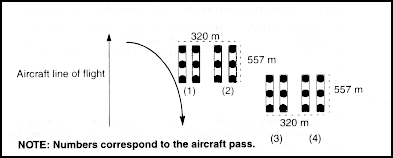
Figure D-2. Turn obstacle
Block
A block minefield (Figure D-3) is designed to stop an enemy advance along a specific AA or allow it to advance at an extremely high cost. Block minefields are obstacles with intensive integrated fires. They should be employed in a complex obstacle scheme with road craters or bridge demolitions enhancing the effectiveness of the minefield. One air Volcano aircraft can lay a 557- by 320-meter block minefield, using all 160 canisters (800 AT/160 AP mines). The probability of mine encounter is more than 80 percent. One Volcano aircraft can lay one block minefield, making two passes side by side (see Table D-2).
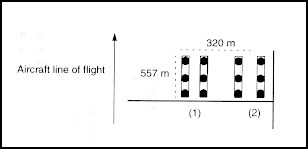
Figure D-3. Block obstacle
Disrupt
A disrupt minefield (Figure D-4) fractures and breaks up enemy formations. It causes premature commitment of reduction assets, interrupts C 2 , and alters timing. A disrupt minefield is not resource- or time-intensive. The probability of mine encounter is approximately 50 percent, and the typical width is 278 by 120 meters. It takes 40 canisters (200 AT/40 AP mines) to emplace one disrupt minefield. One air Volcano aircraft can lay four disrupt minefields (see Table D-2).
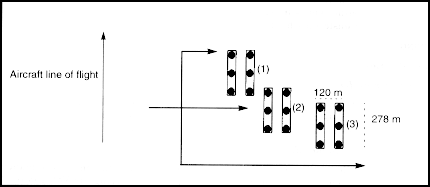
Figure D-4. Disrupt obstacle
Fix
A fix minefield (Figure D-5) slows enemy formations within a specified EA. It gives friendly forces time to acquire, target, and destroy enemy formations. A fix minefield is employed in depth and causes enemy formations to react and breach repeatedly. The air Volcano fix minefield does not look impenetrable to enemy formations. The probability of mine encounter is 50 percent, and the typical size is 278 by 120 meters. It takes 40 canisters (200 AT/40 AP mines) to emplace one fix minefield. One air Volcano aircraft can lay four fix minefields (see Table D-2).
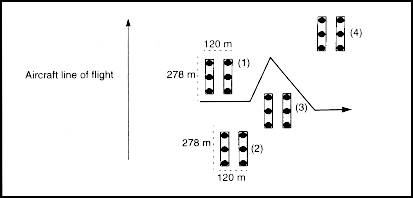
Figure D-5. Fix obstacle
Linear
If the threat situation allows, the aircrew makes a pass to confirm the minefield end points and the suitability of the terrain. In a high-threat situation, the aircrew emplaces the minefield on the first pass. This hasty minefield is linear in configuration and is 1,115 by 75 meters. All 160 canisters are fired.
PLANNING
Responsibilities
Division Commander
The division commander approves air Volcano employment and integration into deep, close, and rear operations. He is also the authority for SCATMINE employment.
Maneuver Brigade Commander
When authority is delegated by the division commander, the maneuver brigade commander is responsible for employing air Volcano in close operations and in supporting follow-on missions. He is responsible for approving target nominations to be submitted to the division. The maneuver brigade commander receives the air Volcano aircraft and its crew in OPCON status.
Aviation Brigade Commander
The aviation brigade commander is responsible for integrating the air Volcano into deep aviation attacks and for shaping EAs in the division AO. He executes the air Volcano missions in deep, close, and rear operations. The aviation brigade commander submits target nominations to the division targeting cell through the aviation brigade engineer and provides support for transporting and loading Volcano mines.
Division Engineer
The division engineer is responsible for target nominations that support division missions or objectives in deep operations. He--
- Submits the nominations to the division targeting cell.
- Determines minefield characteristics.
- Incorporates the Volcano minefield, DTG of SD times, and safety zones into the division obstacle plan.
- Estimates the requirements for mine canisters and Class IV/V supplies.
- Determines the intent of the Volcano minefield as it is integrated into the division obstacle plan.
- Disseminates the SCATMINWARN to adjacent and subordinate units before the minefield is laid and one hour before the SD sequence of the minefield is initiated.
Brigade Engineer
The brigade engineer is responsible for target nominations that support objectives within his respective fight. He--
- Submits target nominations to the assistant division engineer.
- Synchronizes air Volcano missions into brigade operations.
- Assists the brigade FSE in planning SEAD, CAS, and Apache escort.
- Provides logistics estimates to the brigade S4 for coordination of ammunition requirements.
- Posts the operations map with the minefield's location, aviation graphics, the safety zone, and the DTG of SD times.
- Disseminates the SCATMINWARN to adjacent and subordinate units before the minefield is laid and one hour before SD sequence of the minefield is initiated.
Deputy Fire-Support Coordinator
The deputy FSCOORD recommends commanding general/chief of staff approval for target nominations developed by the division targeting cell. He is responsible for submitting division-approved air Volcano target nominations to the G3 air for inclusion in the air coordination order. He coordinates SEAD, CAS, and intelligence and electronic warfare for division-directed air Volcano missions. The deputy FSCOORD is also responsible for--
- Targeting (intelligence and asset coordination).
- The air tasking order.
- The G3 air coordination order.
- G2 collection and assessment.
G3 Air
The G3 air synchronizes coordination and deconfliction of division air space for air missions, SEAD, and CAS. When necessary, he submits the air coordination order to higher headquarters with the division-approved target list.
Emplacing Unit/UH-60 Company
The emplacing unit or the designated UH-60 company sets up and loads the air Volcano system in conjunction with the forward-area refuel point. The Volcano system is loaded on the UH-60 at the designated point. The emplacing unit/UH-60 company is also responsible for--
- Maintaining the unit basic load at the forward-area refuel point or ATP.
- Preparing the scatterable minefield report and record, forwarding it to the authorizing commander or the aviation brigade engineer, and verifying that the assistant division/brigade engineer receives the entire report.
- Coordinating air routes and corridors.
- Requesting SEAD and security aircraft.
- Planning the air-mission coordination meeting to refine or develop the aviation scheme of maneuver.
- Ensuring that pilots attend the unit's rehearsal.
- Posting aviation graphics on the current operations overlay.
Process
All target nominations are submitted through the division targeting cell. In the brigade, all target nominations go to the assistant division engineer for submission to the board. Nominations should be submitted 96 hours prior to the execution time (see Table D-3).
- The targeting cell validates the targets based on the SITEMP and recommends approval through the commanding general/chief of staff.
- Upon approval, the deputy FSCOORD turns the target numbers and the air requirements over to the G3 air, who adds the targets to the air coordination order.
- The deputy FSCOORD begins to plan SEAD/CAS requirements for division missions.
- The G3 issues the division WO so that units can be prepared to execute specific air Volcano missions.
- The division issues a fragmentary order (FRAGO) to order the execution of the air Volcano mission.
- The planning staff gives the aviation brigade a date and a time for the air Volcano system to be uploaded and prepared for employment.
- Air Volcano minefields are integrated into the scheme of maneuver as a directed, situational, or reserve obstacle as stated in FM 90-7. This includes integration into the COA that is synchronized during war gaming and included in the OPORD as part of the rehearsal.
|
NEWSLETTER
|
| Join the GlobalSecurity.org mailing list |
|
|
|

